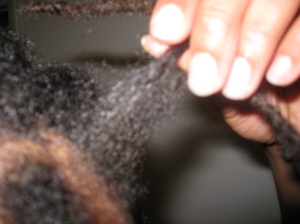 Tell me a little about you. How long have you done natural hair?
Tell me a little about you. How long have you done natural hair?
Hair was always a very important part of grooming in my family, and I learnt the basics from my mother. Once she thought I was good enough, she split the Sunday-night corn-row duty with me, and we’d sit together doing my younger sisters’ hair. From that starting point, I’d be ask to style hair by extended family members, school-mates, friends of friends, even strangers off the street.
Once I started wearing my hair in locs 3 years ago, the scope expanded to include inter-locking, palm-rolling, treating & styling locs.
Do you work in a salon or from a home location?
Depending on what is convenient for the client, he/she visits my home location, or I go to their home.

Do you have a Facebook group or other social networking site?
These days, I mostly disseminate info via my twitter account – rhapsodyinD
What type of services do you provide?
I provide most basic services – washing, treating, styling for natural hair and locs. I stay away from chemical services, including colouring.
How much experience do you have with maintaining & styling locks?
3 years
What is your biggest challenge when dealing with locks?
One of the challenges for me in dealing with locs – both mine, and others’ – is allowing the beauty to come from the hair, rather than superimposing an external concept. I think locs is a hairstyle which allows the hair to develop its unique character, and this should be embraced. There can be frustration sometimes when the locs don’t do what I want them to do, whether in terms of the rate of maturing, rate of growth, or styling. At these times, I realize it’s necessary to take a step back, to look for the beauty already present in the hair, and nurture what is there, rather than try to make it something it is not.

With customers?
My biggest challenge with customers stems from this same issue, as often, individuals come to me with a concept in mind based on something they’ve seen done with someone else’s hair, whether by another stylist or by myself. As I myself face the challenge of getting to know each client’s hair, I challenge them to do the same – to get to know their own hair – its unique needs and its unique strengths, and use this knowledge to determine treatment and style options.
What products do you typically use on natural hair?
The more natural the product, the better. For products available in store, I check the ingredient list and religiously avoid petrolatum, and any product with too many chemicals. The short the ingredient list, the better. Generally, though, I very much lean towards combining oils and plant products to create treatments or hair sprays for daily grooming, based on the needs of the hair and scalp. My favorite combo includes glycerin for its humectant properties, vitamin E for damage repair and peppermint oil for scalp stimulation & fragrance. I also favor egg treatments, raw aloe vera, tea-tree oil and olive oil.

What suggestions do you give people when they come to you needing their hair done for a formal event?
The basic choice is between wearing the hair down or in an up-do. It’s always nice to do the opposite of however they usually wear their hair day-to-day. I consider the hair’s strength to determine how much manipulation it can handle, and the individual’s face structure in determining the overall shape of the style.
What suggestions do you give people who need a formal look that will last into casual events as well?
Most styles are quite versatile. An updo can be transformed simply by letting the back down. Hair accessories are easily interchanged.
What advice do you give new customers?
I encourage everyone to get to know their hair – its strength level, elasticity, moisture needs, etc., to educate themselves on what it needs, and not to be dependent on any groomer or stylist. Very often, persons leave their hair completely in the hands of supposed professionals to their own detriment. My best customer is an educated customer who knows his/her hair, who works together with me not only for short-term glamour, but long term strength & growth.
How far in advance should someone schedule an appointment prior to their event?
It seems most individuals, aiming for ‘freshness’ like to have their hair done on the same day. I personally vouch for the day before, especially for up-dos.
Do you have consultations available? If so, how long to the appointments run?
I usually incorporate this into my first appointment with a client.
What are most requested styles: for women? For men?
Women tend to prefer anything going up, and men anything going back 🙂



























